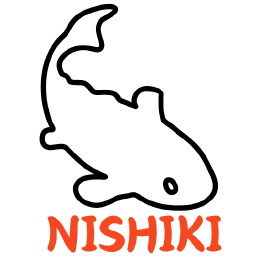Top 5 Japanese Koi Varieties Koi fish have long been celebrated for their vibrant colors and serene presence, making them…

We have many of the popular Koi varieties like Kohaku, Sanke, Showa, Ogon, Bekko, Shusui and Asagi.
$70/per

We have many of the popular Koi varieties like Kohaku, Sanke, Showa, Ogon, Bekko, Shusui and Asagi..
$90/per
We have many of the popular Koi varieties like Kohaku, Sanke, Showa, Ogon, Bekko, Shusui and Asagi.
$120/per
We have many of the popular Koi varieties like Kohaku, Sanke, Showa, Ogon, Bekko, Shusui and Asagi.
$180/per
$8/per
Pearlscale is a spherical-bodied fancy goldfish with doubled finnage similar to the fantail.
$10/per
We offer mix set. It’s included many of varieties goldfish like Ryukin, Wakin and Comet. One set has 3 goldfish.
$20/set
Specialty goldfish can be also provided.
ex) Ranchu, Panda
Please contact us.
$60

4/6/8 Inch
Braided Metal Handle Large Square Net with Soft Fine Mesh Sludge Food Residue Wastes Skimming Cleaning Net for Fish
$12
NISHIKI offers a full range of services from breeding and sales of high-quality Koi and Goldfish to aftercare and support. We supply breeding fish and provide expert guidance, ideal for individual enthusiasts, gardeners, and companies looking for aquariums and Japanese-style gardens.





Green water is caused by free-floating algae and is common in new ponds or springtime. Prolonged green water signals an unbalanced pond (too many fish, not enough plants). Check out our advice pages for tips on how to control algae and maintain clear water in your pond.
(Click here to learn more)
Stop feeding fish when water is below 50°F (10°C). Keep a hole in the ice with a de-icer or aerator, and clear leaves and debris from the pond. Prune aquatic plants, and bring tropical ones indoors. For full winter prep, see our advice page on Preparing Your Pond for Winter.
String algae occur in most ponds and help water quality, but can become unsightly. You can remove it by hand, and for extreme cases, use products like Pond Balance or Clarity Max to prevent regrowth. These treatments are effective and safe for your pond’s ecosystem.
There’s no strict rule, but aim for one inch of fish per square foot of pond surface. Consider filtration, water circulation, and plant life. Start with a few fish, adding gradually, as koi can grow over 2 feet. For more details, visit our advice page on fish stocking.
Feed your fish based on water temperature: not below 50°F (10°C), once every few days above 60°F (15.5°C), and twice daily in summer. Feed only what they can eat in five minutes, as uneaten food lowers water quality. In well-planted ponds, supplemental feeding may be unnecessary.
If you have fish, filtration is essential for water clarity and health. High-quality filters are easier to maintain. Ensure your pump and filter match your pond size for optimal performance. Visit our advice pages for tips on selecting a pond filter and pump.
(Click here to learn more)
Koi spawn once per year in spring, producing many eggs, though few survive. Goldfish spawn multiple times throughout summer. Both species can lead to a growing population. Visit our Koi Spawning Behaviour page for more details and tips to manage pond fish populations.
(Click here to learn more)
A pump provides oxygen and water circulation, working with the filter to maintain pond health. Choose a pump that circulates your pond’s volume at least once every two hours. Bigger pumps are useful for waterfalls. For more details, see our advice page on selecting pond pumps.
(Click here to learn more)
Top 5 Japanese Koi Varieties Koi fish have long been celebrated for their vibrant colors and serene presence, making them…
Maintaining a Koi pond requires regular care to ensure the health and vitality of your fish. A well-maintained pond not…
Understanding Koi and Goldfish Koi and Goldfish may seem similar, but there are some key differences. Koi can live…
